
Packages Troubleshooting
Packages Troubleshooting provides an analysis of a variety of package configurations and how these different scenarios will affect the data stored in the financial tables. Not all scenarios have been described. Rather an overview of those most commonly package configurations in the Asia Pacific Region. This topic is intended for Installers and Support technicians with a good familiarity with the OPERA PMS application.
The following terms are used.
Guest Account Debit (GAD). These are amounts the guest has consumed. For example, Rooms Revenue, F&B, Paid Outs, Taxes etc. GAD transactions appear on the guest folio and from within the billing screen, guest account. Guest Account Debits are Revenue-generating transaction types also known as Consumption or Sale items.
Guest Account Credit (GAC). These are usually payments applied to the guest account, for example, Cash, Mastercard, and Visa. GAC transactions appear on the guest folio and from within the billing screen, guest account. A GAC transaction is also called a Payment type transaction.
Package Debit (PDR). Whenever a guest purchases a package, these are the amounts internally posted to that account that are owed to the guest. For example, a package of 250.00 inclusive of a breakfast would generate an internal charge of $200 for Room and $50.00 for breakfast into PDR. PDR transactions are internal transactions only and not seen in the application. PDR transactions are also considered Consumption or Sale transactions just like Guest Account Debit.
Package Credit (PCR). Whenever a guest purchases a package, these are the amounts posted by the system whenever a package amount is consumed. If the amounts are not consumed then the system will post a package profit. PCR transactions are internal transactions only and usually not seen in the application.
Item Price. This is the cost of the package to the property. The system will reference this amount when posting allowances for the package.
Allowance (Amount). This is the maximum allowance given to the guest for that package. OPERA will refer to both the item price and allowance when posting packages. The system will post a package loss when the consumed amount is larger than the item price but less than the allowance. Once the amount posted is greater than the allowance, then OPERA will charge the extra amount to the guest as an Overage.
Product. This is the code that has been defined for that package. Each package uses a unique code.
Following are print screens of the transactions codes used during this analysis.
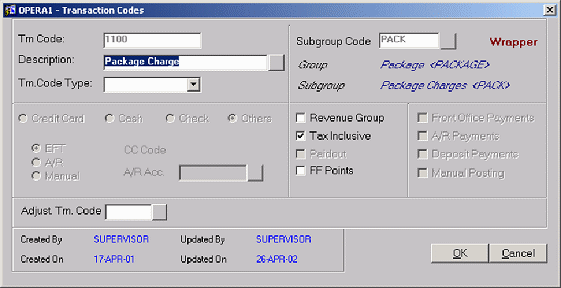
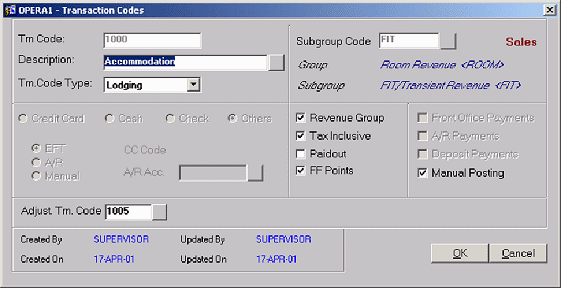
The Tax Inclusive/Exclusive checkbox is irrelevant for this wrapper code. There must not be generates on the wrapper code. The purpose of the wrapper is as a system code used to post the package rate amount. It is not revenue and should not be configured as such.
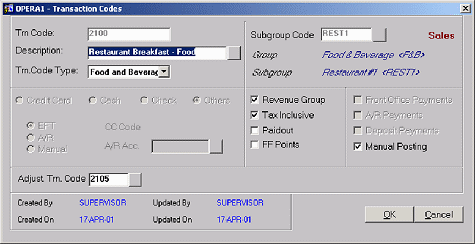
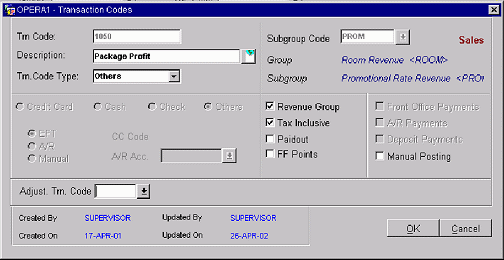
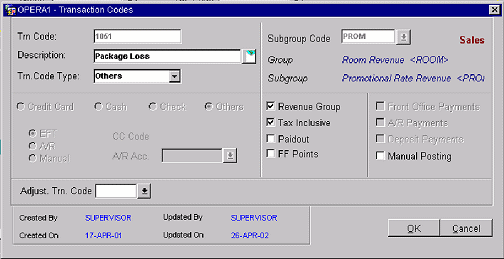
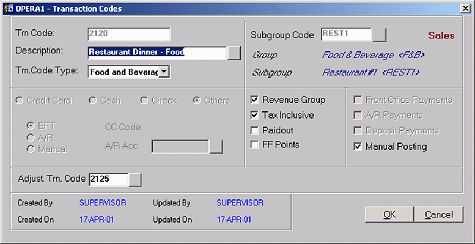
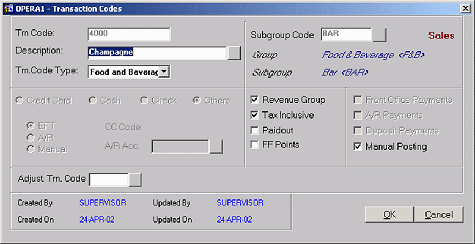
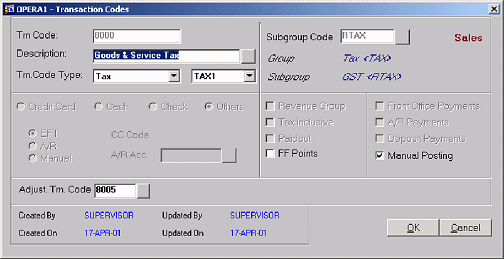
Note: All scenarios are based on one person in the room.
Package Amount: $200.00
Allowance: $50.00
Item Price: $25.00
In this example, we have created an inclusive rate of $200.00 that included breakfast to the value of $25.00 per person. Internally we have given an allowance of up to $50.00, which the guest can use but is unaware of this amount. The guest went to the breakfast outlet and consumed $24.00 worth of F&B.
Arrival: 01-Mar-2003
Departure: 02-Mar-2003
Rate Code: 2NTSBRK
Package Rate: 200.00
Pax: 1
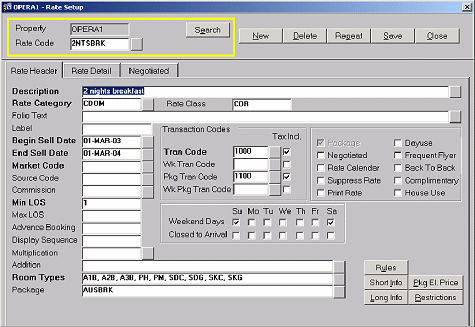
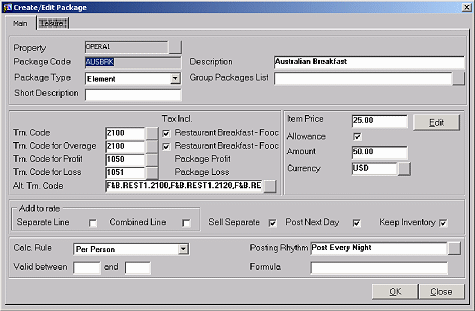
On the End of Day Sequence of March 1, the 200.00 package charge is applied to the guest account and a next day allowance of $25.00 is posted to the Package Ledger. The guest consumes breakfast on March 2 and a POS charge of $24.00 is debited against the guest account. OPERA will then offset this charge against the allowance that was generated during the End of Day Sequence. In this scenario an internal package profit is posted.
In the financial_transactions table, the result is as follows:
Trx_date |
Trx_code |
GAD |
GAC |
PDR |
PCR |
Product |
Reference |
01-mar |
1100 |
|
|
|
175.00 |
|
[NA Pkg. Trx] |
01-mar |
1100 |
200.00 |
|
|
|
|
[NA Pkg. Trx] |
01-mar |
1000 |
|
|
175.00 |
|
|
[NA Room] |
01-mar |
8000 |
|
|
|
|
|
[Add: 10%(B)] |
02-mar |
2100 |
|
|
|
25.00 |
AUSBRK |
[NA Pkgs.NEXTDAY.AUSBRK] |
02-mar |
2100 |
|
|
24.00 |
|
|
#CHECK 111 POS charge |
02-mar |
8000 |
|
|
|
|
|
[Add: 10%(B)] |
02-mar |
9000 |
|
200.00 |
|
|
|
|
02-mar |
1050 |
|
|
1.00 |
|
|
[Pkg. Profit Price=>25.00 Consumption=>24.00] |
Totals |
|
200.00 |
200.00 |
200.00 |
200.00 |
|
|
Q: When is the 1050 posted?
A: The transaction code 1050 is posted at checkout time because the guest was departing on March 2 (1-night stay). It is a result of the next day allowance on the package posted during the End of Day Sequence that the guest partially consumed. If the guest were staying two nights or more, it would have posted during the audit of March 2.
Package Allowances are either posted at check-in or during the End of Day Sequence. Reconciliation of the package allowance happens at either End of Day Sequence or check-out. If an allowance is set for Post Next Day, the concept of business date (current date) and transaction date comes into play in the financial_transactions table. The business date and transaction date are usually the same date unless it is a Post Next Day package. These transactions use the trx_date field to determine when the posting is supposed to take place even though the allowance may be posted on a previous date (arrival date). A floating allowance can only be reconciled at check-out time as that is the only time we can be 100% sure that a package was consumed completely or not.
Note: The Effective Package Ledger looks at the business date of the transaction. Package Ledger looks at the transaction date of the transaction.
Q: What values should there be for 8000 Tax; these rows are empty (tax inclusive)?
A: Yes in this case they are tax inclusive but we do display them in other columns in the financial_transactions table such as trx_amt and net_amt. They just aren't on the chart above because they are internal although we do use them on the gstfolio as appropriate.
Q: Which of these transactions is regarded as revenue and which are internal/non revenue posting?
A: The table that shows the configuration of the transaction codes is called trx_codes. Within the table there is a column called tc_transaction_type which is an indicator per transaction of its classification, meaning:
For Accounting purposes:
You will see these same indicators within the financial_transactions table under the column name called FT_Subtype. These will affect both the Guest Account Debit (GAD) and the Guest Account Credit (GAC).
In this scenario the guest spent $24.00 for breakfast. The allowance was up to $50.00 but the item price was $25.00. OPERA posted a Package Profit of $1.00 in this case.
An example of the Package Ledger part of the Trial Balance for this reservation would look as follows:
Note: The opening balance amount is an example.
Opening Balance 100.00
Balance from 28-FEB |
680.00 |
580.00 |
Postings for 01-MAR: |
Debit |
Credit |
1000 Accommodation |
175.00 |
|
1100 Package Charge |
|
175.00 |
2100 Restaurant Breakfast |
|
|
8000 Goods & Services Tax |
|
|
Total |
175.00 |
175.00 |
Closing Balance 100.00
Opening Balance 100.00
Balance from 01-MAR |
680.00 |
580.00 |
Postings for 02- MAR: |
Debit |
Credit |
1000 Accommodation |
|
|
1100 Package Charge |
|
|
2100 Restaurant Breakfast |
25.00 |
25.00 |
8000 Goods & Services Tax |
|
|
Total |
25.00 |
25.00 |
Closing Balance 100.00
Package Amount: $200.00
Allowance: $50.00
Item Price: $25.00
In this example, we have created an inclusive rate of $200.00 that included breakfast to the value of $25.00 per person. Internally we have given an allowance of up to $50.00, which the guest can use but is unaware of this amount. The guest went to the breakfast outlet and consumed exactly $25.00 worth of F&B. The configuration is:
Arrival: March 1, 2003
Departure: March 2, 2003
Rate Code: 2NTSBRK
Package Rate: 200.00
Pax: 1


On the End of Day Sequence of March 1, the $200.00 room charge is applied to the guest and a next day allowance of $25.00 is created internally by the system. The guest goes to the breakfast outlet on March 2 and a POS charge of $25.00 is debited against the guest account. OPERA will then apply this charge against the allowance that was generated during the End of Day Sequence.
In this scenario the guest spent $25.00 for breakfast, which matched the allowed consumption. The system did not post any package profit or loss. The charge from the POS was totally consumed against the allowance.
An example of the Package Ledger part of the Trial Balance for this reservation would look as such:
Note: Opening balance amount is an example.
Package Ledger
Opening Balance 100.00
Balance from Feb 28 |
680.00 |
580.00 |
Postings for March 1 |
Debit |
Credit |
1000 Accommodation |
175.00 |
|
1100 Package Charge |
|
175.00 |
2100 Restaurant Breakfast |
|
|
8000 Goods & Services Tax |
|
|
Total |
175.00 |
175.00 |
Closing Balance 100.00
Opening Balance 100.00
Balance from March 1 |
680.00 |
580.00 |
Postings for March 2 |
Debit |
Credit |
1000 Accommodation |
|
|
1100 Package Charge |
|
|
2100 Restaurant Breakfast |
25.00 |
25.00 |
8000 Goods & Services Tax |
|
|
Total |
25.00 |
25.00 |
Closing Balance 100.00
Accommodation: $200.00 Inclusive
Allowance: $50.00
Item Price: $25.00
In this example, we have created an inclusive rate of $200.00 that included breakfast to the value of $25.00 per person. Internally we have given an allowance of up to $50.00, which the guest can use but is unaware of this amount. The guest went to the breakfast outlet and was really hungry after a long flight the previous day and consumed $35.00 worth of F&B. The configuration is:
Arrival: February 27, 2003
Departure: February 28, 2003
Rate Code: CROWN
Room Rate: 200.00
Pax: 1
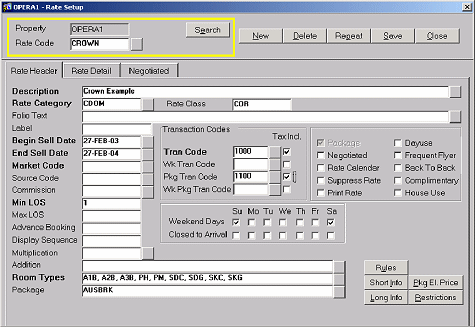
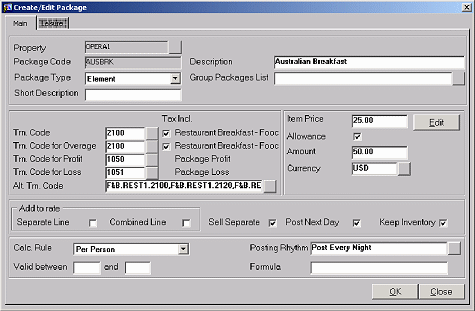
On the End of Day Sequence of February 27, the $200.00 room charge is applied to the guest and a next day credit for the item price of $25.00 is created internally by the system. The guest goes to the breakfast outlet on February 28 and a POS charge of $35.00 is debited against the guest account. OPERA will then apply this charge against the allowance that was generated during the End of Day Sequence. The resultant is that the item price was exceeded, but the allowance wasn't. The guest doesn't have to pay the extra $10.00 at the F&B outlet. Internally, the property accepts a package loss and accordingly we post to this transaction code configured for package loss. This is classified as a Package Loss. Usually in this case the property will pay the F&B outlet the difference.
The guest account would appear from cashier billing as follows:
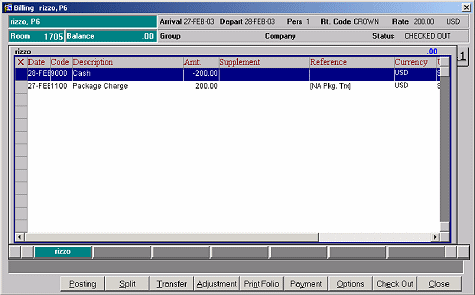
An example of the Package Ledger part of the Trial Balance for this reservation would look as follows:
Note: Opening balance amount is an example.
Opening Balance 100.00
Balance from Feb 27 |
|
680.00 |
|
580.00 |
Postings for Feb 28 |
Debit |
|
Credit |
|
1000 Accommodation |
|
175.00 |
|
|
1051 Package Loss |
|
|
|
|
1100 Package Charge |
|
|
|
175.00 |
2100 Restaurant Breakfast |
|
|
|
|
8000 Goods & Services Tax |
|
|
|
|
Total |
|
175.00 |
|
175.00 |
Closing Balance 100.00
Opening Balance 100.00
Balance from Feb 28 |
|
680.00 |
|
580.00 |
Postings for March 1 |
Debit |
|
Credit |
|
1000 Accommodation |
|
|
|
|
1051 Package Loss |
-10.00 |
|
|
|
1100 Package Charge |
|
|
|
|
2100 Restaurant Breakfast |
35.00 |
25.00 |
|
|
8000 Goods & Services Tax |
|
|
|
|
Total |
25.00 |
25.00 |
|
|
Closing Balance 100.00
Accommodation: $200.00
Allowance: $50.00
Item Price: $25.00
In this example, we have created an inclusive rate of $200.00 that included breakfast to the value of $25.00 per person. Internally we have given an allowance of up to $50.00, which the guest can use but is unaware of this amount. The flight was a red eye so the guest didn't have the time to have breakfast.
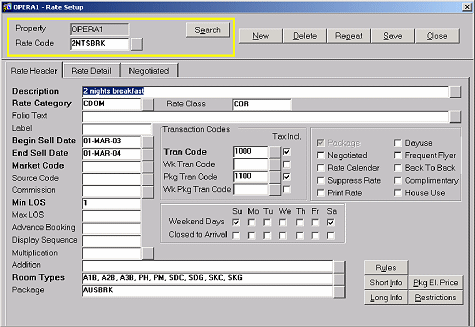
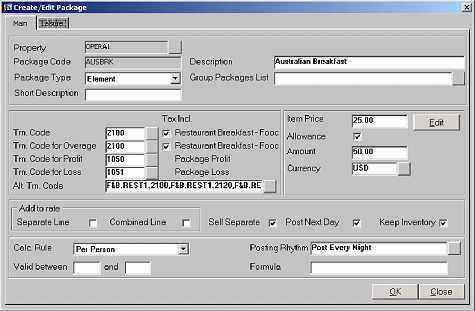
On the End of Day Sequence of March 1, the $200.00 room charge is applied to the guest and a next day allowance of $25.00 is created internally by the system. As the guest did not consume anything at breakfast and OPERA had generated an allowance for the next day of $25.00, internally the system will post a package profit of $25.00. In the table financial_transactions, the result is as follows:
Trx_date |
Trx_code |
GAD |
GAC |
PDR |
PCR |
Product |
Reference |
March 1 |
1100 |
|
|
|
175.00 |
|
[NA Pkg. Trx] |
March 1 |
1100 |
200.00 |
|
|
|
|
[NA Pkg. Trx] |
March 1 |
1000 |
|
|
175.00 |
|
|
[NA Room] |
March 1 |
8000 |
|
|
|
|
|
[Add: 10%(B)] |
March 1 |
2100 |
|
|
|
25.00 |
AUSBRK |
[NA Pkgs.NEXTDAY.AUSBRK] |
March 2 |
8000 |
|
|
|
|
|
[Add: 10%(B)] |
March 2 |
9000 |
|
200.00 |
|
|
|
|
March 2 |
1050 |
|
|
25.00 |
|
|
[Pkg. Profit Price=>25.00 Consumption=>0.00] |
Totals |
|
200.00 |
200.00 |
200.00 |
200.00 |
|
|
An example of the Package Ledger part of the Trial Balance for this reservation would look as follows:
Note: Opening balance amount is an example.
Opening Balance 100.00
Balance from Feb 28 |
|
680.00 |
|
580.00 |
Postings for March 1 |
Debit |
|
Credit |
|
1000 Accommodation |
|
175.00 |
|
|
1050 Package Profit |
|
|
|
|
1100 Package Charge |
|
|
|
175.00 |
2100 Restaurant Breakfast |
|
|
|
|
8000 Goods & Services Tax |
|
|
|
|
Total |
|
175.00 |
|
175.00 |
Closing Balance 100.00
Opening Balance 100.00
Balance from March 1 |
|
680.00 |
|
580.00 |
Postings for March 2 |
Debit |
|
Credit |
|
1000 Accommodation |
|
|
|
|
1050 Package Profit |
|
25.00 |
|
25.00 |
1100 Package Charge |
|
|
|
|
2100 Restaurant Breakfast |
|
|
|
|
8000 Goods & Services Tax |
|
|
|
|
Total |
|
25.00 |
|
25.00 |
Closing Balance 100.00
Accommodation: $290.00 Inclusive
Dinner: $70.00 Allowance
Champagne: $20.00 Allowance
In this example, we have created an inclusive rate of $290.00 that includes a bottle of champagne worth $20.00 on arrival and a dinner allowance of $70.00 that posts every night. Internally we have given an allowance of up to $20.00 for champagne flat rate to post on arrival, and post a $70.00 allowance per adult for dinner for each night of the stay. The configuration is:
Arrival: February 21, 2003
Departure: February 22, 2003
Rate Code: DINCHAMP
Adults: 1
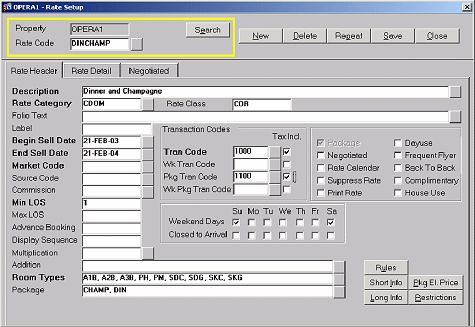
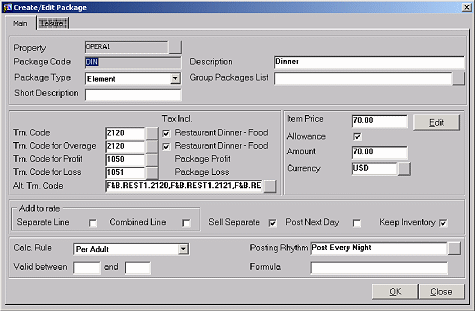
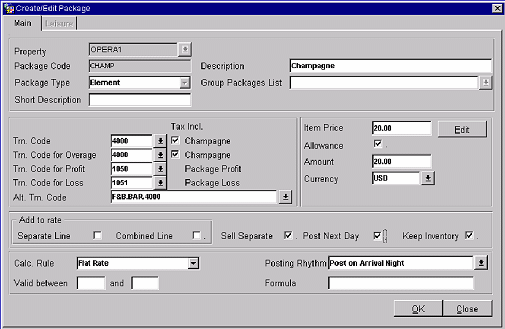
During the End of Day Sequence the system posted the package amount of $290.00 to the guest bill as a package charge. Internally we did the following:
Q: Wouldn't the allowance for champagne be created on check-in rather than during the End of Day Sequence?
A: No, it is a Post Next Day package so the allowance will be created in the End of Day Sequence.
Date |
Trx Code |
GAD |
GAC |
PDR |
PCR |
Product |
Reference |
Feb 21 |
1100 |
290.00 |
|
|
|
|
[NA Pkg. Trx] |
Feb 21 |
2120 |
|
|
|
70.00 |
DIN |
[Pkgs.@Chkin/NA] |
Feb 21 |
1100 |
|
|
|
200.00 |
|
[NA Pkg. Trx] |
Feb 21 |
1000 |
|
|
200.00 |
|
|
[NA Room] |
Feb 21 |
8000 |
|
|
|
|
|
[Add: 10%(B)] |
Feb 21 |
4000 |
|
|
|
20.00 |
|
[NA Pkgs.NEXTDAY.CHAMP] |
Feb 21 |
2120 |
|
|
70.00 |
|
DIN |
POS charge of 125.50 |
Feb 21 |
8000 |
|
|
|
|
|
[Add: 10%(B)] |
Feb 21 |
2120 |
55.50 |
|
|
|
DIN |
[Overage] |
Feb 21 |
8000 |
|
|
|
|
|
[Add: 10%(B)] |
Feb 22 |
9000 |
|
345.50 |
|
|
|
Cash Payment |
Feb 22 |
1050 |
|
|
20.00 |
|
CHAMP |
[Pkg. Profit Price=>20.00 Consumption=>.00] |
Feb 22 |
8000 |
|
|
|
|
|
[Add: 10%(B)] |
Totals |
|
345.50 |
345.50 |
290.00 |
290.00 |
|
|
The guest bill will look like this:
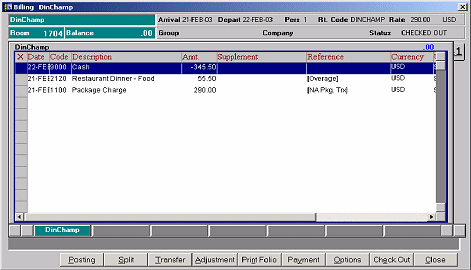
An example of the Package Ledger part of the Trial Balance for this reservation would look as follows:
Note: Opening balance amount is an example.
Opening Balance 100.00
Balance from Feb 20 |
|
680.00 |
|
580.00 |
Postings for Feb 21 |
Debit |
|
Credit |
|
1000 Accommodation |
|
200.00 |
|
|
1050 Package Profit |
|
|
|
|
1100 Package Charge |
|
|
|
200.00 |
2120 Restaurant Dinner |
70.00 |
70.00 |
|
|
4000 Champagne |
|
20.00 |
|
|
8000 Goods & Services Tax |
|
|
|
|
Total |
270.00 |
290.00 |
|
|
Closing Balance 80.00
Opening Balance 80.00
Balance from March 1 |
|
680.00 |
|
580.00 |
Postings for March 2 |
Debit |
|
Credit |
|
1000 Accommodation |
|
|
|
|
1050 Package Profit |
|
20.00 |
|
|
1100 Package Charge |
|
|
|
|
2120 Restaurant Dinner |
|
|
|
|
4000 Champagne |
|
|
|
|
8000 Goods & Services Tax |
|
|
|
|
Total |
|
20.00 |
|
00.00 |
Closing Balance 100.00
Accommodation: $290.00 Inclusive
Dinner: $70.00 Floating allowance consumed on final night, flat rate
Champagne $20.00 Arrival night allowance, flat rate
Arrival: 24-Feb-03
Departure: 27-Feb-03
Rate Code: 3DAYDINNER
Adults: 1

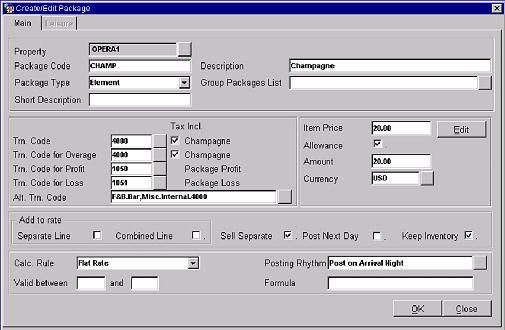
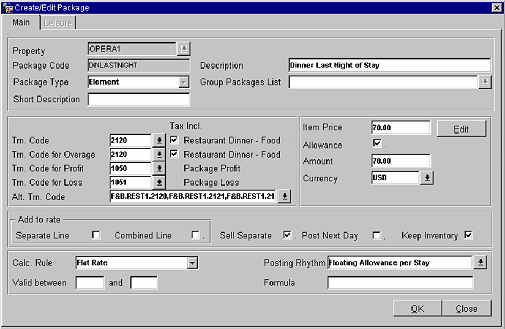
Date |
Trx Code |
GAD |
GAC |
PDR |
PCR |
Product |
Reference |
24-Feb |
4000 |
|
|
|
20.00 |
CHAMP |
[Pkgs.@Chkin/NA] |
24-Feb |
1100 |
|
|
|
270.00 |
|
[NA Pkg. Trx] |
24-Feb |
1100 |
290.00 |
|
|
|
|
[NA Pkg. Trx] |
24-Feb |
1000 |
|
|
270.00 |
|
|
[NA Room] |
24-Feb |
8000 |
|
|
|
|
|
[Add: 10%(B)] |
24-Feb |
1050 |
|
|
20.00 |
|
CHAMP |
[Pkg. Profit Price=>20.00 Consumption=>.00] |
24-Feb |
8000 |
|
|
|
|
CHAMP |
[Add: 10%(B)] |
25-Feb |
1100 |
|
|
|
290.00 |
|
[NA Pkg. Trx] |
25-Feb |
1100 |
290.00 |
|
|
|
|
[NA Pkg. Trx] |
25-Feb |
1000 |
|
|
290.00 |
|
|
[NA Room] |
25-Feb |
8000 |
|
|
|
|
|
[Add: 10%(B)] |
26-Feb |
2120 |
|
|
|
70.00 |
DINLASTN |
[Pkgs.@Chkin/NA] |
26-Feb |
2120 |
|
|
70.00 |
|
DINLASTN |
|
26-Feb |
8000 |
|
|
|
|
|
[Add: 10%(B)] |
26-Feb |
2120 |
86.00 |
|
|
|
|
[Overage] (146.00 posted from POS) |
26-Feb |
8000 |
|
|
|
|
|
[Add: 10%(B)] |
26-Feb |
1100 |
|
|
|
220.00 |
|
[NA Pkg. Trx] |
26-Feb |
1100 |
290.00 |
|
|
|
|
[NA Pkg. Trx] |
26-Feb |
1000 |
|
|
220.00 |
|
|
[NA Room] |
26-Feb |
8000 |
|
|
|
|
|
[Add: 10%(B)] |
27-Feb |
9000 |
|
956.00 |
|
|
|
Cash Payment |
Total |
|
956.00 |
956.00 |
870.00 |
870.00 |
|
|
Q: If the allowance for dinner were a floating allowance, wouldn't it be created on check-in like the other allowances?
A: No, The allowance is dynamically retrieved at the time of consumption and that information is not stored in the financial_transaction table. The allowance is posted at the time the package is consumed. If the floating package is not consumed during the stay, it is posted at checkout and considered package profit.
In this example, upon check-in the system generated the internal package credit for $20.00 being for champagne consumption. The butler forgot to take the bottle to the room so the property made a package profit. The system posted $20.00 to package debit to show this.
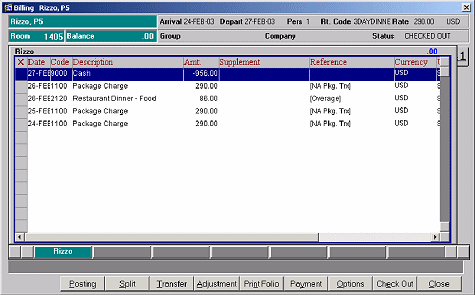
Q: What will the trial_balance look like?
A: Similar to the package breakdown by stay above except it will list the breakdown of charges for today. The package part of the Trial Balance will appear like this for 24 to 26-Feb-2003:
Opening Balance 100.00
Balance from 23-Feb |
680.00 |
|
580.00 |
Postings for 24-Feb: |
Debit |
Credit |
|
1000 Accommodation |
270.00 |
|
|
1050 Profit |
20.00 |
|
|
1100 Package Charge |
|
|
270.00 |
2120 Restaurant Dinner |
|
|
|
4000 Champagne |
|
|
20.00 |
8000 Goods & Services Tax |
|
|
|
Total |
290.00 |
|
290.00 |
Closing Balance 100.00
Opening Balance 100.00
Balance from 24-Feb |
680.00 |
|
580.00 |
Postings for 25-Feb: |
Debit |
Credit |
|
1000 Accommodation |
|
|
|
1100 Package Charge |
290.00 |
290.00 |
|
2120 Restaurant Dinner |
|
|
|
4000 Champagne |
|
|
|
8000 Goods & Services Tax |
|
|
|
Total |
290.00 |
290.00 |
|
Closing Balance 100.00
Opening Balance 100.00
Balance from 25-Feb |
680.00 |
|
580.00 |
Postings for 26-Feb: |
Debit |
Credit |
|
1000 Accommodation |
220.00 |
|
|
1100 Package Charge |
|
|
220.00 |
2120 Restaurant Dinner |
70.00 |
|
70.00 |
4000 Champagne |
|
|
|
8000 Goods & Services Tax |
|
|
|
Total |
290.00 |
|
290.00 |
Closing Balance 100.00
Q: What do I balance with?
A: There are 3 main reports to consider for package balancing:
The Trial Balance will display the breakdown of transaction codes for the Package Ledger. You can balance the Effective Package Distribution report by transaction code to the Trial Balance report (per day).
The Effective Package distribution lists the package transactions grouped by guest name. This allows you to see the package breakdown that each guest has generated.
These reports should be included as part of End of Day Sequence reports and checked on a daily basis against each other.